Scimitar oryx
| Scimitar oryx | |
|---|---|
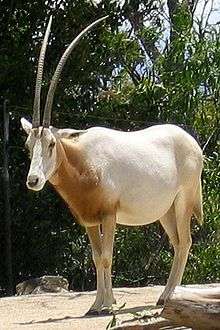 | |
| Adult at Taronga Zoo | |
| Scientific classification | |
| Kingdom: | Animalia |
| Phylum: | Chordata |
| Class: | Mammalia |
| Order: | Artiodactyla |
| Family: | Bovidae |
| Subfamily: | Hippotraginae |
| Genus: | Oryx |
| Species: | O. dammah |
| Binomial name | |
| Oryx dammah Cretzschmar, 1827 | |
The scimitar oryx or scimitar-horned oryx (Oryx dammah), also known as the Sahara oryx, is a species of Oryx now extinct in the wild. It formerly inhabited all of North Africa. It has a long taxonomic history since its discovery in 1816 by Lorenz Oken, who named it the Oryx algazel. This spiral-horned antelope stands a little more than 1 metre (3.3 ft) at the shoulder. The males weigh 140–210 kg (310–460 lb) and the females weigh 91–140 kg (201–309 lb). The coat is white with a red-brown chest and black markings on the forehead and down the length of the nose. The calves are born with a yellow coat, and the distinguishing marks are initially absent. The coats change to adult coloration at 3–12 months old.
The scimitar oryx formed herds of mixed sexes of up to 70 members, usually guided by the bulls. They inhabited semideserts and deserts and were adapted to live in the extreme heat, with their efficient cooling mechanism and very low requirement of water. Scimitar oryx feed on foliage, grasses, succulent plants and plant parts during the night or early morning. Births peak between March and October. After a gestation of eight to nine months, one calf is born. Soon after, the female has a postpartum estrus.
The scimitar oryx was once widespread in northern Africa. Its decline began as a result of climate change, and later it was hunted extensively for its horns. Today, it is bred in captivity in special reserves in Tunisia, Morocco and Senegal. The scimitar oryx was domesticated in Ancient Egypt and is believed to have been used as food and sacrificed as offerings to gods. Wealthy people in Ancient Rome also bred them. The use of their valuable hides began in the Middle Ages. The unicorn myth may have originated from sightings of a scimitar oryx with a broken horn.
Taxonomy and naming
The scimitar oryx is a member of the genus Oryx and family Bovidae. The German naturalist Lorenz Oken first described it in 1816, naming it Oryx algazel. The nomenclature has undergone various changes since then, with the introduction of names like Oryx tao, O. leucoryx, O. damma, O. dammah, O. bezoarticus and O. ensicornis. In 1826, Philipp Jakob Cretzschmar used the name Oryx ammah for the species. A year later, the name Orys leucoryx came into use, but as this was a synonym of the Arabian oryx (then called Oryx beatrix), it was abandoned, and Oryx algazel was accepted once more. Over a hundred years later, in 1951, Sir John Ellerman and Terence Morrison-Scott realized the invalidity of the name Oryx algazel. Finally, in January 1956, the International Trust for Zoological Nomenclature accepted Oryx dammah as the scientific name. There have been no more changes since then, though many papers published after 1956 created confusion by using names like O. gazella tao.[2]
Its scientific name, Oryx dammah, is derived from: Ancient Greek ὄρυξ (orux), meaning a gazelle or antelope (originally a pickaxe[3]); Latin damma (fallow deer or antelope); and Arabic dammar (sheep).[4] The scimitar oryx is named for its horns,[5] which resemble scimitars.[4] Its common name in English is "scimitar-horned oryx", or simply "scimitar oryx".[2]
Genetics and evolution
The scimitar oryx has 58 chromosomes. It has one pair of large submetacentric autosomes and 27 acrocentric autosomal pairs. The X and Y chromosomes are the largest and smallest acrocentrics.[6] The first molecular study of this species (published in 2007) observed genetic diversity among European, North American and some other captive groups. Divergence was found within the mitochondrial DNA haplotypes, and was estimated to have taken place between 2.1 and 2.7 million years ago. Population increases occurred approximately 1.2 and 0.5 million years ago.[7]
In another study, intended to note genetic differences between Oryx species, karyotypes of Oryx species and subspecies – namely O. gazella, O. b. beisa, O. b. callotis, O. dammah and O. leucoryx – were compared with the standard karyotype of Bos taurus. The number of autosomes in all karyotypes was 58. The X and Y chromosomes were conserved in all five species.[8]
Physical description
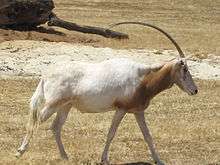
The scimitar oryx is a straight-horned antelope that stands just over 1 m (3.3 ft) at the shoulder. The males weigh 140–210 kg (310–460 lb) and the females 91–140 kg (201–309 lb).[9] The body measures 140–240 cm (55–94 in) from the head to the base of the tail. The tail is 45–60 cm (18–24 in) long and ends with a tuft. They are sexually dimorphic with males being larger than females.[10]
Its coat is white with a red-brown chest and black markings on the forehead and down the length of the nose.[4] The coat reflects the sun's rays, while the black portions and the tip of the tongue provide protection against sunburn.[11][12] The white coat helps to reflect the heat of the desert.[13] Calves are born with yellow coats and lack distinguishing marks, which appear later in life.[14] Their pelage changes to adult coloration at 3–12 months old.[11]
Both sexes have horns, but those of the females are more slender.[14] The horns are long, thin, and symmetrical; they curve backwards (a distinctive feature of this species) and can reach 1.0 to 1.2 m (3 ft 3 in to 3 ft 11 in) on both the males and the females. The horns are so thin that they can break easily.[4] The female has four nipples. The large, spreading hooves are well adapted to allow these antelopes to walk on the sand of their dry habitats.[5] A scimitar oryx can live as long as 20 years.[4][13][15] At Smithsonian National Zoo, a female oryx died at 21, an exceptional age since females generally have a lifespan of about 15 years.[16]
Diseases and parasites
The scimitar oryx can be infected with cryptosporidiosis, a parasitic disease caused by protozoan parasites of genus Cryptosporidium in the phylum Apicomplexa. A study in 2004 revealed that C. parvum or similar organisms infected 155 mammal species, including the scimitar oryx.[17] An analysis in 2005 found Cryptosporidium parasites in stool samples from 100 mammals, including the scimitar oryx.[18] Oocysts of a new parasite, Eimeria oryxae, have been discovered in the feces of a scimitar oryx from Zoo Garden in Riyadh.[19] In France, Streptococcus uberis was isolated for the first time in an oryx. It had caused vegetative endocarditis in the animal, leading to fatal congestive heart failure.[20]
A 1983 study examined the blood serum chemistry of blood samples taken from the jugular veins of fifty scimitar oryx ranging from neonates to adults over 13 years old. The study concluded that the higher eosinophil counts of the juveniles and adults might reflect larger internal parasite burdens in them as compared with the neonates.[21]
Ecology and behavior
The scimitar oryx was a very sociable animal and traveled in herds of between two and forty individuals, generally, led by a dominant bull. This species once gathered in groups of several thousand for migration. During the wet season, they migrated north into the Sahara.[14] Scimitar oryx are diurnal. In the cool early mornings and evenings, they rest under trees and shrubs, or if neither are available, they dig depressions in the soil with their hooves and rest there. Males fight often, but not for long and not violently. Predators, such as lions, leopards, hyenas, cheetahs, golden jackals, vultures and Cape hunting dogs, mostly kill weak and young oryx.[2][4]
The play activity of eight calves in captivity was observed in a 1983 study. Male calves played for longer than females calves did. Mixed sex play was usual; selection of partners depended on age, but not on sex or genetic relatedness. Results suggested that size dimorphism was an important factor responsible for sex differences in play.[22]
Adaptations
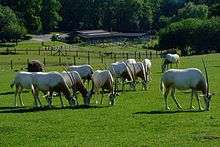
With a metabolism that functions at the high temperatures prevalent in their habitats, scimitar oryx need less water for evaporation to help conduct heat away from the body, enabling them to go for long periods without water. They can allow their body temperature to rise to almost 46.5 °C (115.7 °F) before beginning to perspire.[5] In times of ample supply, oryx can use fluid loss through urination and feces to lower their body temperature to below 97 °F (36 °C) at night, giving more time before reaching maximum body temperature the following day.[14] They can tolerate high temperatures that would be lethal to most mammals. They have a network of fine blood vessels that carry blood from the heart to the brain, passing close to the nasal passage and thus allowing the blood to cool by up to 5 °F (3 °C) before reaching the brain, which is one of the most heat-sensitive organs of the body.[13][14]
Diet
The habitat of scimitar oryx in the wild was steppe and desert, where they ate foliage, grass, herbs, shrubs, succulent plants, legumes, juicy roots, buds, and fruit.[14] They can survive without water for nine to ten months because their kidneys prevent water loss from urination – an adaptation to desert habitats. They can get water from water-rich plants such as the wild melon (Citrullus colocynthis) and Indigofera oblongifolia and from the leafless twigs of Capparis decidua. In the night or early morning, they often search for plants such as Indigofera viscosa, which produce a hygroscopic secretion that fulfils water requirements. They eat tuft grasses such as Cymbopogon schoenanthus after it has rained, but they normally prefer more palatable grasses, such as Cenchrus biflora, Panicum laetum and Dactyloctenium aegyptium. When the dry season begins, they feed on the seedpods of Acacia raddiana, and during the dry season, they rely on perennial grasses of genera such as Panicum (especially Panicum turgidum) and Aristida, and browse plants such as Leptadenia species, Cassia italica and Cornulaca monacantha.[2]
Reproduction

Both males and females reach sexual maturity at 1.5 to 2 years of age.[4] Births peak between March and October.[4] Mating frequency is greater when environmental conditions are favorable. In zoos, males are sexually most active in autumn.[2] The estrous cycle lasts roughly 24 days, and females experience an anovulatory period in spring. Periods between births are less than 332 days, showing that the scimitar oryx is polyestrous.[23]
Courting is done by means of a mating circle: the male and female stand parallel to one another, facing in opposite directions, and then circle around each other until the female allows the male to mount from behind. If the female is not ready to mate, she runs away and circles in the reverse direction.[14] Pregnant females leave the herd for a week, give birth to the calf and conceive again during their postpartum estrus; thus they can produce a calf a year.[11] Gestation lasts about nine months, after which a single calf is born, weighing 20 to 33 pounds (9.1 to 15.0 kg).[14] Twin births are very rare - only 0.7% of the births observed in one study. Both mother and calf return to the main herd within hours of the birth.[4] The female separates herself from the herd for a few hours while she nurses the calf. Weaning starts at 3.5 months, and the young become fully independent at around 14 weeks old.[5]
Habitat and distribution
The scimitar oryx once inhabited grassy steppes, semideserts[14] and deserts in a narrow strip of central north Africa (Niger and Chad).[5] It was widespread on the fringes of the Sahara, mainly in subdesert steppe, the grassy zone between the real desert and the Sahel, an area characterized by an annual rainfall of 75–150 mm (3.0–5.9 in). In 1936, a single herd of 10,000 oryx was seen in the steppe area of Chad. By the mid-1970s, Chad was home to more than 95% of the world population of this species.[24]
Status and conservation
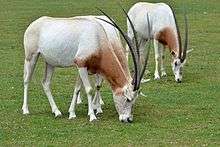
The scimitar oryx was hunted almost to extinction for its horns. Its population decline began as a result of major climatic changes that caused the Sahara to become dry. The northern population was already almost lost before the 20th century. The decline of the southern population accelerated as Europeans began to settle the area and hunt them for meat, hides and horn trophies. World War II and the Civil War in Chad that started in the 1960s are thought to have caused heavy decreases of the species through an increase in hunting for food.[5][25] Roadkill, nomadic settlements near waterholes (their dry-season feeding places) and firearms for easy hunting have also reduced numbers.[26]
The IUCN lists the scimitar oryx as regionally extinct in Algeria, Burkina Faso, Chad, Egypt, Libya, Mali, Mauritania, Morocco, Niger, Nigeria, Senegal, Sudan, Tunisia and Western Sahara, and has assessed it as extinct in the wild since 2000. Reports of sightings in Chad and Niger remain unsubstantiated, despite extensive surveys carried out throughout Chad and Niger from 2001 to 2004 in an effort to detect antelopes in the Sahel and the Sahara. At least until 1985, 500 oryx were estimated to be surviving in Chad and Niger, but by 1988, only a few individuals survived in the wild.[1]
There is now a global captive breeding program for the scimitar oryx.[27] In 2005, at least 1,550 captives were managed as part of breeding programs, and in 2008, more than 4,000 were believed to be held in private collections in the United Arab Emirates.[1] Reintroduction plans involve fenced-in herds in Bou Hedma National Park (1985),[28] Sidi Toui National Park (1999) and Oued Dekouk National Park (1999) in Tunisia; Souss-Massa National Park (1995) in Morocco; and Ferlo Faunal Reserve (1998) and Guembuel Wildlife Reserve (1999) in Senegal.[1]
In culture
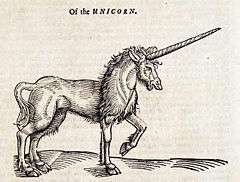
Ancient times
In ancient Egypt scimitar oryx were domesticated[12] and tamed, possibly to be used as offerings for religious ceremonies or as food.[15] They were called ran and bred in captivity. In ancient Rome they were kept in paddocks and used for coursing, and wealthy Romans ate them. The scimitar oryx was the preferred quarry of Sahelo-Saharan hunters. Its hide is of superior quality, and the king of Rio de Oro sent 1000 shields made of it to a contemporary in the Middle Ages. Since then, it has been used to make ropes, harnesses and saddlery.[2]
Unicorn myth
The myth of the one-horned unicorn may have originated from sightings of injured scimitar oryx; Aristotle and Pliny the Elder held that the oryx was the unicorn's "prototype".[29] From certain angles, the oryx may seem to have one horn rather than two,[30][31] and given that its horns are made from hollow bone that cannot be regrown, if an oryx were to lose one of its horns, for the rest of its life it would have only one.[29]
References
- 1 2 3 4 IUCN SSC Antelope Specialist Group (2008). Oryx dammah. In: IUCN 2008. IUCN Red List of Threatened Species. Retrieved 9 September 2009. Database entry includes justification for why this species is listed as extinct in the wild.
- 1 2 3 4 5 6 Gilbert, T.; Woodfine, T. (2004). The Biology, Husbandry and Conservation of Scimitar-horned Oryx (Oryx dammah) (PDF) (2nd ed.). United Kingdom: Marwell Preservation Trust. ISBN 978-0-9521397-2-0.
- ↑ Harper, Douglas. "oryx". Online Etymology Dictionary. Retrieved 2013-02-21.
- 1 2 3 4 5 6 7 8 9 Huffman, B. "Oryx dammah ( Scimitar-horned oryx )". Ultimate Ungulate.
- 1 2 3 4 5 6 "Scimitar-horned oryx (Oryx dammah)". ARKive.
- ↑ Claro, F.; Hayes, H.; Cribiu, E.P. (1994). "The C-, G-, and R-banded karyotype of the scimitar-horned oryx (Oryx dammah)". Hereditas 120 (1): 1–6. doi:10.1111/j.1601-5223.1994.00001.x. PMID 8206781.
- ↑ Iyengar, A.; Gilbert, T.; Woodfine, T.; Knowles, J. M.; Diniz, F. M.; Brenneman, R. A.; Louis, E. E.; Maclean, N. (1 June 2007). "Remnants of ancient genetic diversity preserved within captive groups of scimitar-horned oryx (Oryx dammah)". Molecular Ecology 16 (12): 2436–49. doi:10.1111/j.1365-294X.2007.03291.x.
- ↑ Kumamoto, A.T.; Charter, S.J.; Kingswood, S.C.; Ryder, O.A.; Gallagher, Jr., D.S. (1999). "Centric fusion differences among Oryx dammah, O. gazella, and O. leucoryx (Artiodactyla, Bovidae)". Cytogenetic and Genome Research 86 (1): 74–80. doi:10.1159/000015416.
- ↑ Mungall, E.C. (2007). Exotic Animal Field Guide : Nonnative Hoofed Mammals in the United States (1st ed.). College Station: Texas A&M University Press. p. 169. ISBN 1-58544-555-X.
- ↑ Hoath, R. (2009). "Other Artiodactyla- Family Bovinae". A Field Guide to the Mammals of Egypt. Cairo: Amer Univ In Cairo Press. p. 149. ISBN 978-977-416-254-1.
- 1 2 3 "Scimitar-horned Oryx (Oryx dammah)". World Association of Zoos and Aquariums (WAZA).
- 1 2 "Oryx dammah" (PDF). Sahelo-Saharan Megafauna. Sahelo-Saharan Antelopes.
- 1 2 3 "Scimitar-horned Oryx". National Zoological Park.
- 1 2 3 4 5 6 7 8 9 Johnson, H. "Oryx dammah". University of Michigan Museum of Zoology. Animal Diversity Web.
- 1 2 "Scimitar-horned oryx". Safari West.
- ↑ Zoon, J. (22 March 2012). "Elderly Oryx Dies at Smithsonian's National Zoo". Smithsonian Newsdesk. Retrieved 15 October 2012.
- ↑ Fayer, R. (2004). "Cryptosporidium: a water-borne zoonotic parasite". Veterinary Parasitology 126 (1–2): 37–56. doi:10.1016/j.vetpar.2004.09.004. PMID 15567578.
- ↑ Alves, M.; Xiao, L.; Lemos, V.; Zhou, L.; Cama, V.; Cunha, M. B. da; Matos, O.; Antunes, F. (2005). "Occurrence and molecular characterization of Cryptosporidium spp. in mammals and reptiles at the Lisbon Zoo". Parasitology Research 97 (2): 108–12. doi:10.1007/s00436-005-1384-9.
- ↑ Alyousif, M.S.; Al-Shawa, Y.R. (April 2002). "A new coccidian parasite (Apicomplexa: Eimeriidae) from the scimitar-horned oryx, Oryx dammah". Journal of the Egyptian Society of Parasitology 32 (1): 241–6. PMID 12049259.
- ↑ Chai, N. (December 1999). "Vegetative endocarditis in a scimitar-horned oryx (Oryx dammah)". Journal of zoo and wildlife medicine : official publication of the American Association of Zoo Veterinarians 30 (4): 587–8. PMID 10749451.
- ↑ Bush, M.; Custer, R. S.; Whitla, J. C.; Montali, R. J. (1983). "Hematologic and serum chemistry values of captive scimitar-horned oryx (Oryx tao): variations with age and sex". The Journal of Zoo Animal Medicine 14 (2): 51. doi:10.2307/20094637.
- ↑ Pfeifer, S. (1985). "Sex differences in social play of scimitar-horned oryx calves (Oryx dammah)". Zeitschrift für Tierpsychologie 69 (4): 281–92. doi:10.1111/j.1439-0310.1985.tb00153.x.
- ↑ Morrow, C.J.; Wildt, D.E.; Monfort, S.L. (1999). "Reproductive seasonality in the female scimitar-horned oryx (Oryx dammah)". Animal Conservation (Cambridge University Press) 2 (4): 261–8. doi:10.1111/j.1469-1795.1999.tb00072.x.
- ↑ East, R. (1990). West and Central Africa. (PDF). Gland: IUCN. p. 27. ISBN 2-8317-0016-7.
- ↑ "Oryx dammah (O. tao)". Animal Info.
- ↑ Newby, J. (2009). "Can Addax and Oryx be saved in the Sahel?". Oryx 15 (03): 262. doi:10.1017/S0030605300024662.
- ↑ United Nations Environment Programme (2008). Africa: Atlas of Our Changing Environment (PDF). Nairobi, Kenya: United Nations Environment Programme. ISBN 978-92-807-2871-2.
- ↑ Godon, I.J.; Gill, J.P. (2007). "Reintroduction of Scimitar-horned oryx Oryx dammah to Bou-Hedma National Park, Tunisia". International Zoo Yearbook 32 (1): 69–73. doi:10.1111/j.1748-1090.1993.tb03517.x.
- 1 2 Rice, M. (1994). The Archaeology of the Arabian Gulf, c. 5000–323 BC. Routledge. p. 63. ISBN 0-415-03268-7.
- ↑ "Arabian Oryx". Natural History Museum of Los Angeles County. Archived from the original on 2007-10-10. Retrieved 2008-01-25.
- ↑ Tongren, S. (1981). What's for Lunch: Animal Feeding at the Zoo. GMG Publications.
External links
 Media related to Oryx dammah at Wikimedia Commons
Media related to Oryx dammah at Wikimedia Commons Data related to Oryx dammah at Wikispecies
Data related to Oryx dammah at Wikispecies
